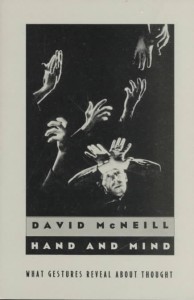
[H]ow are human thoughts disclosed in gestures? When people talk they can be seen making spontaneous movements called gestures. These are usually movements of the arms and hands and are closely synchronized with the flow of speech. The implication of gestures that interests me is the possibility of embracing in one theoretical system two forms of expression, speech and action. Gestures and speech occur in very close temporal synchrony and often have identical meanings. Yet they express these meanings in completely different ways. Comparing speech to gesture produces an effect on our understanding of language and thought something like the effect of triangulation in vision. Many details, previously hidden, spring out in a new dimension. Rather than causing us to slice a person analytically into semi-isolated modules, taking gesture into account encourages us to see something like the entire person as a theoretical entity—his thinking, speaking, willing, feeling, and acting, as a unit. …
Gestures exhibit images that cannot always be expressed in speech, as well as images the speaker thinks arc concealed. Speech and gesture must cooperate to express the person’s meaning. A conception of language and gesture as a single integrated system is sharply different from the notion of a “body language”—a communication process utilizing signals made up of body movements, which is regarded by its believers as separate from and beyond normal language. …
Gestures and language … differ from each other on a number of fundamental dimensions. Yet they are also closely linked. The following describes some of these linkages. Such linkages imply that gestures and speech should be viewed within a unified conceptual framework as aspects of a single underlying process:
1. Gestures occur only during speech. While emblems and pantomimes may be delivered in utter silence, the gestures that are the focus of attention for us are almost invariably accompanied by speech. … Gesture production and adopting the role of speaker are virtually limited to the same situations. Moreover, 90% of all gestures by speakers occur when the speaker is actually uttering something. The acts of speaking and gesturing are bound to each other in time.
2. Gestures and speech are semantically and pragmatically coexpressive. That is, the gestures that accompany utterances also present the same or closely related meanings semantically and perform the same functions pragmatically. Iconics accompany utterances that depict concrete objects and events and fulfill a narrative function. Metaphorics accompany utterances that refer to the pragmatic structure of the discourse as a whole. They present their own image of the discourse as an object or space or other physical reality. Other gesture types have their own parallels with speech.
The specific linguistic segments that are coexpressive with the gesture are cotemporal. The most meaningful segment of the gesture is the stroke, and it lines up in time with the equivalent linguistic segment, as in the example given in (1.1) where the subject said, “and he [bends it way back],” and the stroke showed bending back during the same interval of time. Such synchrony implies that the speaker is presenting the same meaning in both channels at once. Having a shared meaning could be the basis for integrating gesture and speech into a single performance.
4. Gestures and speech develop together in children. Children’s first gestures are concrete pointing and certain kinds of iconics. Much later they add other kinds of iconics, beats, metaphorics and, last of all, abstract pointing. In general, this progression follows the same path as the development of speech. As children’s speech development moves from a largely referential focus, through descriptive elaboration, and finally to the ability to structure discourse, so their gestures develop from a largely concrete deictic emphasis, through various kinds of iconic gestures, and finally to the discourse-referring gestures-metaphors, abstract pointing, and beats. Beats do not appear at all in children much younger than 5 years and are not abundant until 11 years; yet, considered as movements, beats are the simplest of motions—just flicks of the hand. It is the discourse structure that determines that these flicks have meaning, and the development of this structure is late and the beat gesture itself thus doesn’t occur.
McNeill, David (1992). Hand and Mind: What Gestures Reveal about Thought. Chicago: University of Chicago Press. pp. 10, 23-24. || Amazon || WorldCat
